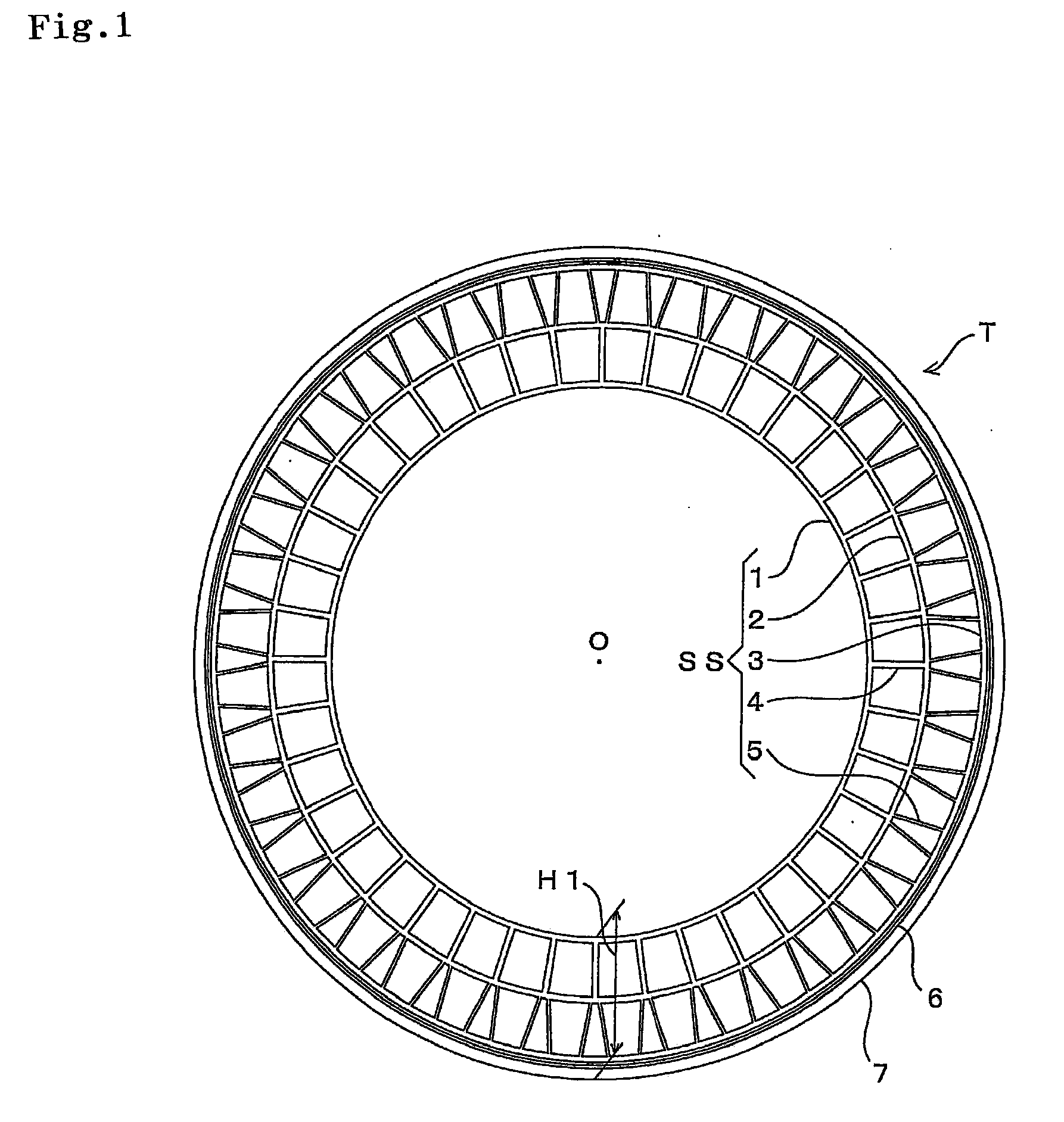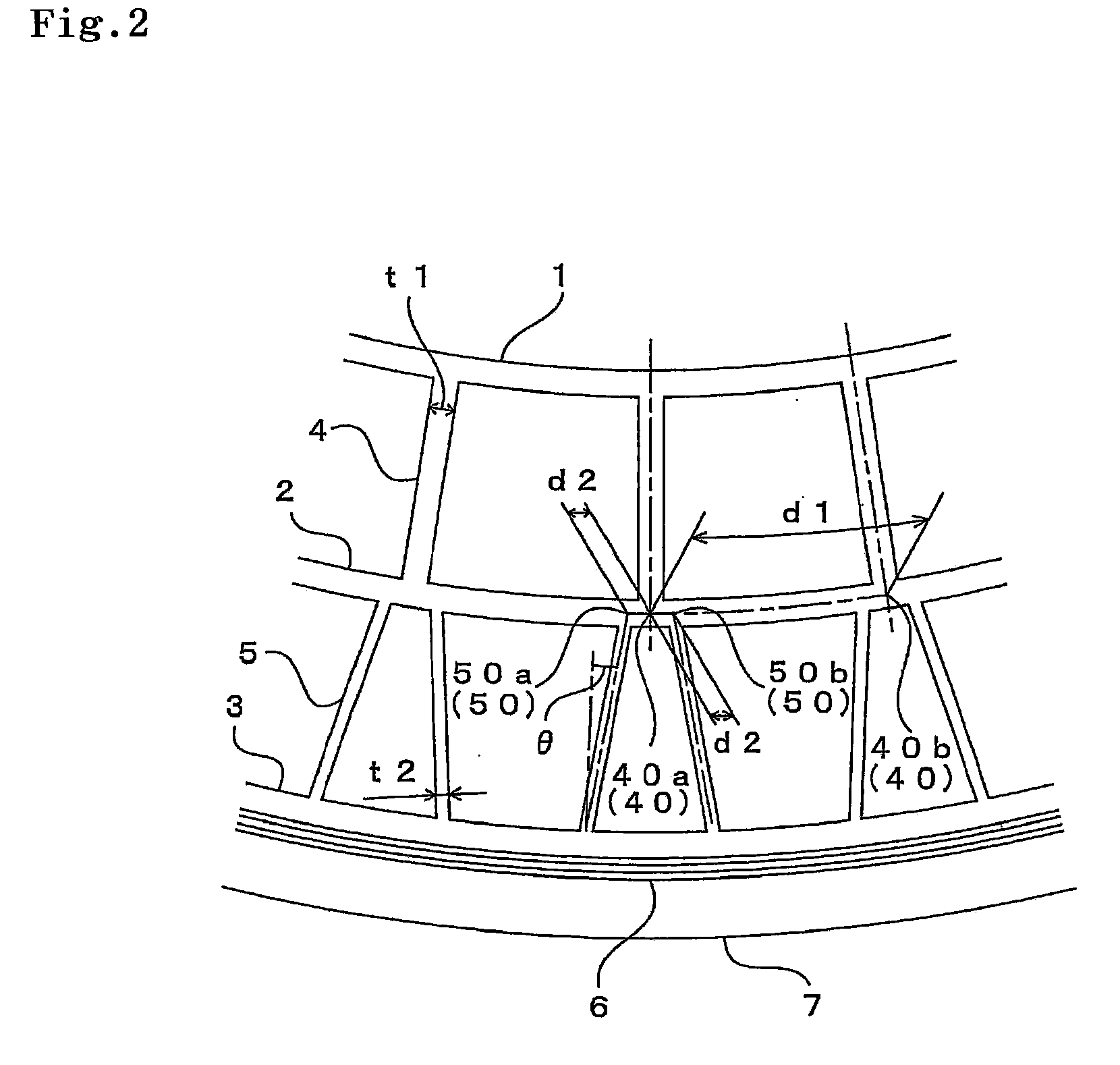[0013]Accordingly, an object of the present invention is to provide a non-pneumatic tire which can improve a riding quality, a
noise performance and the like while improving a durability, and can further sufficiently suppress a buckling of a ground portion between spokes, because a circumferential fluctuation of a tire rigidity is hard to be generated due to a positional relationship between a
spoke position and a center position of the ground surface, and a strain can be dispersed into each of portions of a support structure body.
[0019]Since the non-pneumatic tire according to the present invention is provided with the intermediate annular portion, it is possible to burden the intermediate annular portion with the deformation (the strain) concentrated in the outer coupling portion, at the time when the position of the coupling portion between the outer coupling portion and the outer annular portion is grounded, and it is possible to uniformize the deformation of the support structure body. As a result, in the non-pneumatic tire according to the present invention, the circumferential fluctuation of the tire rigidity is hard to be generated by the positional relationship between the position of the outer coupling portion (the
spoke) and the center position of the ground surface, and it is possible to suppress the buckling of the ground portion between the outer coupling portions. In addition, since the number of the outer coupling portions is larger than the number of the inner coupling portions, the interval between the adjacent outer coupling portions becomes narrow, and it is possible to further suppress the buckling of the ground portion between the outer coupling portions.
[0020]In the non-pneumatic tire according to the present invention, it is preferable that the outer coupling portion is inclined with respect to the tire diametrical direction. Since the outer coupling portion is inclined with respect to the tire diametrical direction, it is possible to burden the intermediate annular portion with the deflection of the outer coupling portion in comparison with the case where the outer coupling portion is the same as the tire diametrical direction, at the time when the position of the coupling portion between the outer coupling portion and the outer annular portion is grounded, and it is possible to uniformize the deformation of the support structure body. As a result, the circumferential fluctuation of the tire rigidity is hard to be generated by the positional relationship between the position of the outer coupling portion and the center position of the ground surface, and it is possible to improve the noise caused by a rolling motion and the riding quality.
[0021]In the non-pneumatic tire according to the present invention, it is preferable that the two outer coupling portions inclined in a direction which is symmetrical with respect to a tire diametrical direction, and the one inner coupling portion along the tire diametrical direction are arranged in a Y-shaped form as seen from a tire axial direction. Since two outer coupling portions and one inner coupling portion are arranged in the Y-shaped form, the coupling portion between the outer coupling portion and the intermediate annular portion comes close to the coupling portion between the inner coupling portion and the intermediate annular portion. Accordingly, it is possible to burden the intermediate annular portion with the deflection of the outer coupling portion accurately. Therefore, it is possible to improve the circumferential fluctuation of the tire rigidity, the suppression of the buckling, and the performances such as the durability, the
rolling resistance and the like. Further, since the coupling portion between the outer coupling portion and the intermediate annular portion comes close to the coupling portion between the inner coupling portion and the intermediate annular portion, the tensile forces tend to be transmitted from each other, and the load supporting performance is increased.
[0022]In the non-pneumatic tire according to the present invention, it is preferable that a thickness of the outer coupling portion is less than a thickness of the inner coupling portion. It is possible to reduce the compression rigidity by making the thickness of the outer coupling portion smaller than the thickness of the inner coupling portion, and it is possible to well suppress the circumferential fluctuation of the tire rigidity. In the present invention, since the number of the outer coupling portions is larger than the number of the inner coupling portions, the compression rigidity of the outer coupling portion is too high if the thickness of the outer coupling portion is equal to or larger than the thickness of the inner coupling portion, so that there is a risk that the suppressing effect of the circumferential fluctuation of the tire rigidity is lowered.
[0023]In the non-pneumatic tire according to the present invention, it is preferable that a gap is provided between an outer coupling point at which one of the two outer coupling portions and the intermediate annular portion are coupled, and an outer coupling point at which the other of the outer coupling portions and the intermediate annular portion are coupled. In the case where two outer coupling portions and one inner coupling portion are arranged in the Y-shaped form as seen from the tire axial direction, the compression force of the inner coupling portion is hard to be directly transmitted to the outer coupling portion by setting the gap between the outer coupling point at which one outer coupling portion and the intermediate annular portion are coupled, and the outer coupling point at which the other outer coupling portion and the intermediate annular portion are coupled, whereby it is possible to prevent the strain in the outer coupling portion from being enlarged. Further, it is possible to burden the intermediate annular portion between two outer coupling points with the tensile force of the inner coupling portion and the outer coupling portion, by setting the gap therebetween. Further, it is assumed that the outer coupling point is a point at which a thickness center line of the outer coupling portion intersects a thickness center line of the intermediate annular portion.
 Login to View More
Login to View More  Login to View More
Login to View More 


